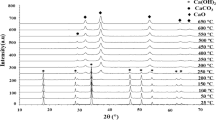Results are given for a study of the effect of treatment temperature on oxidation kinetics of nanodiamond particles. Kinetic models are compared for oxidation by oxygen of nanodiamond powder previously heat treated at different temperatures. It is established that depending on treatment temperature (600 and 1400°C) the kinetic models of oxidation are different. For a specimen treated at 600°C the best model appeared to be two parallel reactions. Oxidation of a specimen heated at 1400°C proceeds according to a model of a single-stage n-th order oxidation reaction. Differences in kinetic models and oxidation reaction kinetic parameters are due to a change in the nature and morphology of specimens, which is connected with nanodiamond transformation into nano-onion-like carbon during heat treatment at a higher temperature.




Similar content being viewed by others
References
E. Fitzer and L. Manocha, Carbon Reinforcements and Carbon / Carbon Composites, Springer Berlin Heidelberg, New York (1998).
G. Bhatia and R. Aggarwal, “Influence of processed carbon black in the filler composition on the characteristics of baked carbon mixes,” J. Mater. Sci., 16(7), 1757 – 1762 (1981).
R. Menendez, J. Fernandeza, J. Bermejo, et al., “The role of carbon black / coal-tar pitch interactions in the early stage of carbonization,” Carbon, 34(7), 895 – 902 (1996).
D. Bansal, S. Pillay, and U. Vaidya, “Nanographite-reinforced carbon/carbon composites,” Carbon, 55, 233 – 244 (2013).
X. Gao, L. Liu, Q. Guo, et al., “Fabrication and mechanical / conductive properties of multi-walled carbon nanotube (MWNT) reinforced carbon matrix composites,” Mater. Lett., 59(24/35), 3062 – 3065 (2005).
D. Lim, J. An, and H. Lee, “Effect of carbon nanotube addition on the tribological behavior of carbon/carbon composites,” Wear, 252(5/6), 512 – 517 (2002).
O. Shenderova, C. Jones, V. Borjanovic, et al., “Detonation nanodiamond and onion-like carbon: applications in composites,” Phys. Stat. Sol. (a), 205(9), 2245 – 2251 (2008).
S. Rakha, R. Raza, and A. Munir, “Reinforcement effect of nanodiamond on properties of epoxy matrix,” Polym. Composite, 34(6), 811 – 818 (2013).
A. Galiguzov, A. Malakho, V. Kulakov, et al., “Use of onionlike carbon to reinforce carbon-carbon composites,” 8th International Conference on High Temperature Ceramic Matrix Composites, Xi’an, China, September 22 – 26 (2013).
P. Morgan, Carbon Fiber and Their Composites, Taylor & Francis Group, Boca Raton, Florida (2005).
S. Awasthi and J. Wood, “Carbon/carbon composite materials for aircraft brakes,” Ceram. Eng. Sci. Proc., 9(7/8), 553 – 560 (1988).
P Walker, Carbon Reaction with Gases, [Russian translation], Izd. Inostr. Lit, Moscow (1963).
B. V. Kantorovich, Introduction to Combustion Theory and Solid Fuel Gasification [in Russian], Metallurgizdat, Moscow (1961).
W. Hoffman, “The importance of active surface-area in the heterogeneous reactions of carbon,” Carbon, 29(6), 769 – 776 (1991).
I. Yavorskii, “Correlation of carbon material structure and reaction capacity,” IV All-Union Conf. “Solid fuel combustion,”, Novosibirsk, 19 – 21 March (1974).
H. Boehm, “Surface oxides on carbon and their analysis: a critical assessment,” Carbon, 40B(2), 145 – 149 (2002).
N. Lavrov, Physicochemical Bases of Fuel Combustion and Gasification [in Russian], Metallurgizdat, Moscow (1957).
S. Rod’kin and Ya. Velikhmaer, “Derivatographic study of carbon reducing agents,” Khim. Tverd. Topliva, No. 2, 82 – 85 (1978).
B. Stanmore, J. Brilhac, and P. Gilot, “The oxidation of soot: a review of experiments, mechanisms and models,” Carbon, 39(15), 2247 – 2268 (2001).
J. Lahaye, P. Boehm, P. Chambrion, et al., “Influence of cerium oxide on the formation and oxidation of soot,” Combust Flame, 104(1/2), 199 – 207 (1996).
J. Neeft, T. Nijhuis, E. Smakman, et al., “Kinetics of the oxidation of diesel soot,” Fuel, 76(12), 1129 – 113 (1997).
A. Ahlstrom and C. Odenbrand, “Combustion characteristics of soot deposits from diesel engines,” Carbon, 27(3), 475 – 483 (1989).
T. Evans and C. Phaal, “The kinetics of diamond-oxygen reaction,” Proc. 5th Carbon Conf. Vol. 1. Pergamon Press (1962).
C. Guillou, J. Rouzaud, N. Findling, et al., “Experimental graphitization and oxidation of nanodiamond and implication for nebular thermal processing,” 40th Lunar and Planetary Science Conference, Woodlands, Texas, March 23 – 27 (2009).
V. Kuznetsov and Y. Butenko, “Nanodiamond graphitization and properties of onion-like carbon. Synthesis, properties and applications of ultra-nanocrystalline diamond,” NATO Science Series, 192, 199 – 216 (2005).
H. Friedman, “New methods for evaluating kinetic parameters from thermal analysis data,” J. Polym. Sci., Polym. Lett., 7, No. 1, 41 – 46 (1969).
Work was carried out with financial support of the Government of the Russian Federation (Russian Ministry of Education and science) within the scope of measures 1.3 (Agreement for supply of a subsidy of the Russian ministry No. 14.579.21.2008 of 5 June 2014). Resolution of the Russian Government of 9 April 2010 No. 218 “Measures of state support for developing cooperation of Russian higher education establishments and organizations implementing comprehensive projects for creating hi-tech production”. Contract No. 02.G36.31.0006.
The work was carried within the scope of an agreement between FKP Aleksin Chemical Combine and the M. V. Lomonosov Moscow State University on the theme “Development of technology and organization of production for heat-resistant composite press-materials for mass preparation of lightweight complex shapes used in aerospace technology, terrestrial and marine transport” according to a resolution of the RF Government of 9 April 2010 No. 218 “Measures of state support for developing cooperation of Russian higher education establishments and organizations implementing a combined project for creating hi-tech production”. Agreement No. 02.G36.31.0006.
Author information
Authors and Affiliations
Corresponding author
Additional information
Translated from Novye Ogneupory, No. 10, pp. 67 – 71, October 2015.
Rights and permissions
About this article
Cite this article
Trofimovich, M.A., Galiguzov, A.A., Tikhonov, N.A. et al. Nanodiamond and Nano-Onion-Like Carbon Oxidation Kinetics. Refract Ind Ceram 56, 561–565 (2016). https://doi.org/10.1007/s11148-016-9887-8
Received:
Published:
Issue Date:
DOI: https://doi.org/10.1007/s11148-016-9887-8




